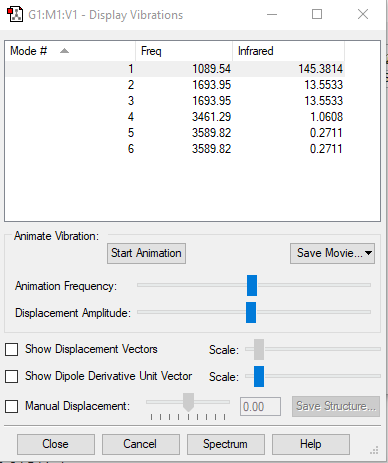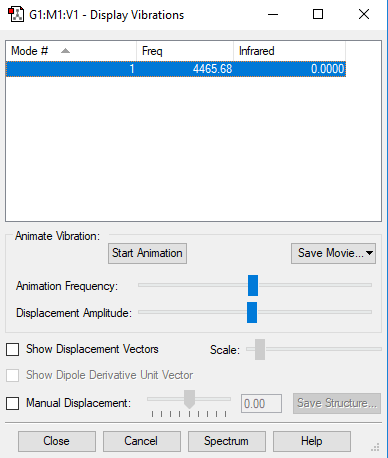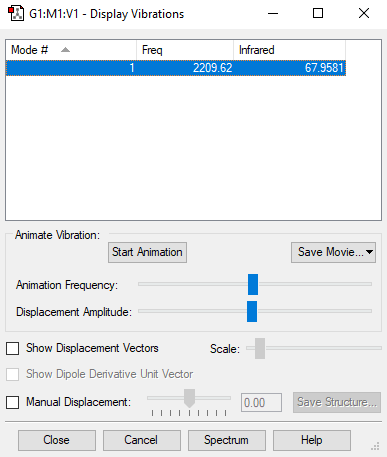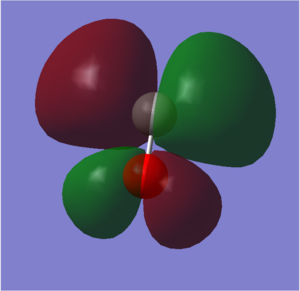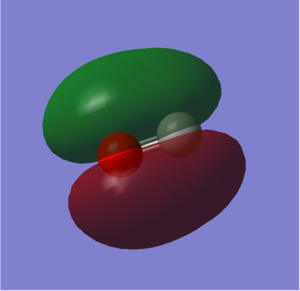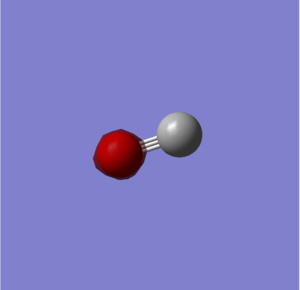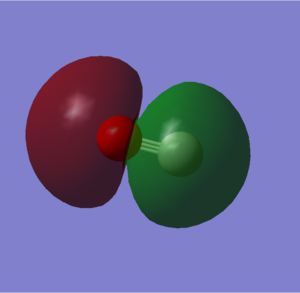Rep:Mod:RumanAhmedsNH3Stuff
NH3
Molecule
Optimised Ammonia |
Molecule Information
Molecule Name: Ammonia
Calculation Method: RB3LYP
Basis Set: 6-31G(d.p)
Final Energy: E(RB3LYP) = -56.55776873 au
RMS Gradient: 0.00000485 au
Point Group: C3v
Bond Length: 1.01798 +- 0.01A
Bond Angle: 105.741 +- 1°
The optimisation file can be accessed by clicking here
Item Value Threshold Converged? Maximum Force 0.000004 0.000450 YES RMS Force 0.000004 0.000300 YES Maximum Displacement 0.000072 0.001800 YES RMS Displacement 0.000035 0.001200 YES Predicted change in Energy=-5.986274D-10 Optimization completed. -- Stationary point found.
Vibrations
| Wavenumber | Symmetry | Intensity (au) |
|---|---|---|
| 1090 | A1 | 145 |
| 1694 | E | 14 |
| 1694 | E | 14 |
| 3461 | A1 | 1 |
| 3590 | E | 0 |
| 3590 | E | 0 |
Questions on Vibrations
1) Modes expected from 3N-6 rule: 3*4-6=6
2) Degenerate Modes: Modes with wavenumbers 1694cm-1 and modes with wavenumbers 3590cm-1
3) Bending Vibrations: 1090cm-1 and 1694cm-1 Bond Stretches: 3461cm-1 and 3590cm-1
4) Highly Symmetric Modes: 3461cm-1 and 1090cm-1
5) Umbrella Mode: 1090cm-1
6) 2 bands
Charge Analysis
Charge on each H: +0.375
Charge on N: -1.125
Overall Charge on Ammonia: 0
The expected charge values for each Hydrogen would be above 0 and below +1, and each Hydrogen would have the same charge value. The expected charge value on the Nitrogen would be -3 multiplied by the charge value of 1 Hydrogen, below 0 and above -3. This is because the N-H bond is polar, due to the Nitrogen being highly electronegative when compared to Hydrogen, so electron density in the N-H bond is withdrawn by the Nitrogen. Because the electron density isn't fully withdrawn, the charge values on each Hydrogen would be greater than 0, but less than 1. And the charge value of the Nitrogen would be -3 multiplied by the charge on a single Hydrogen atom in the molecule.
N2
Molecule
Optimised Nitrogen |
Molecule Information
Molecule Name: Nitrogen
Calculation Method: RB3LYP
Basis Set: 6-31G(d.p)
Final Energy: E(RB3LYP) = -109.52412868 au
RMS Gradient: 0.02473091 au
Point Group: DinfH
Bond Length: 1.10550 +- 0.01A
Bond Angle: There is no bond angle because it is a diatomic molecule.
The optimisation file can be accessed by clicking here
Item Value Threshold Converged?
Maximum Force 0.000001 0.000450 YES
RMS Force 0.000001 0.000300 YES
Maximum Displacement 0.000000 0.001800 YES
RMS Displacement 0.000000 0.001200 YES
Predicted change in Energy=-3.401012D-13
Optimization completed.
-- Stationary point found.
Vibrations
| Wavenumber | Symmetry | Intensity (au) ! |
|---|---|---|
| 2457 | SSG | 0 |
N2 has a single band and is IR inactive.
Charge Analysis
Charge on each Nitrogen atom: 0
Overall Charge on N2: 0
Expected charge on each Nitrogen: 0
Expected charge across entire molecule: 0
The two atoms in N2 are the same; both are Nitrogen. Because of this, they have equal electronegativities and the bond will not be polar.
H2
Molecule
Optimised Hydrogen |
Molecule Information
Molecule Name: Hydrogen
Calculation Method: RB3LYP
Basis Set: 6-31G(d.p)
Final Energy: E(RB3LYP) = -1.17853936 au
RMS Gradient: 0.00000017 au
Point Group: DinfH
Bond Length: 0.74279 +- 0.01A
Bond Angle: There is no bond angle because it is a diatomic molecule.
The optimisation file can be accessed by clicking here
Item Value Threshold Converged?
Maximum Force 0.000000 0.000450 YES
RMS Force 0.000000 0.000300 YES
Maximum Displacement 0.000000 0.001800 YES
RMS Displacement 0.000001 0.001200 YES
Predicted change in Energy=-1.164080D-13
Optimization completed.
-- Stationary point found.
Vibrations
| Wavenumber | Symmetry | Intensity (au) ! |
|---|---|---|
| 4466 | SSG | 0 |
H2 has a single band and is IR inactive.
Charge Analysis
Charge on each Hydrogen atom: 0
Overall Charge on H2: 0
Expected charge on each Hydrogen: 0
Expected charge across entire molecule: 0
The two atoms in H2 are the same; both are Hydrogen. Because of this, they have equal electronegativities and the bond will not be polar.
ConQuest/CCDC
Unique Identifier for complex: GIKGOW01
Link to complex: this is the link
H-H bond in complex: 0.9080 A
Difference in bond lengths: H-H bond in complex is 0.16521 A longer.
The H-H bond in the metal complex is longer due to the Rhenium bonded to one of the Hydrogens in the H-H bond. The Re-H bond withdraws electron density from the H-H bond, weakening the bond. The weakening of the bond causes the bond to elongate.
Energies
E(NH3)= -56.5577687 au
2*E(NH3)= -113.1155375 au
E(N2)= -109.5241287 au
E(H2)= -1.1785394 au
3*E(H2)= -3.5356181 au
ΔE=2*E(NH3)-[E(N2)+3*E(H2)]= -0.0557907 au
= -146.4784829 KJ/mol (au value multiplied by 2625.5)
All values are to 7 dp
The value for ΔE is highly negative, indicating that the reaction is highly exothermic, so energy is released. Therefore, the Ammonia gas is ~146.5 KJ/mol more stable than the reactants.
CO
Molecule
Optimised Carbon Monoxide |
Molecule Information
Molecule Name: Carbon Monoxide
Calculation Method: RB3LYP
Basis Set: 6-31G(d.p)
Final Energy: E(RB3LYP) = -113.30945313 au
RMS Gradient: 0.00010485 au
Point Group: C*v
Bond Length: 1.13786 +- 0.01A
Bond Angle: There is no bond angle because it is a diatomic molecule.
The optimisation file can be accessed by clicking here
Item Value Threshold Converged?
Maximum Force 0.000182 0.000450 YES
RMS Force 0.000182 0.000300 YES
Maximum Displacement 0.000072 0.001800 YES
RMS Displacement 0.000101 0.001200 YES
Predicted change in Energy=-1.301714D-08
Optimization completed.
-- Stationary point found.
Vibrations
| Wavenumber | Symmetry | Intensity (au) ! |
|---|---|---|
| 2210 | SG | 70 |
CO has a single band and is IR active.
Charge Analysis
Charge on Carbon: +0.506
Charge on Oxygen: -0.506
Overall Charge on Carbon Monoxide: 0
Expected charge on Carbon: 0 < Q1 < +1
Expected charge on Oxygen: -Q1 ( -1 < Q2 < 0)
Expected charge across entire molecule: 0
Oxygen has a higher electronegativity than carbon, so electrons within the C-O triple bond will be withdrawn by the oxygen, causing the Carbon to be slightly positively charged, and the Oxygen to become slightly negatively charged.
Molecular Orbital Information
HOMO
This is the HOMO of Carbon Monoxide. It shows mainly p orbital character. It is an occupied antibonding orbital with sigma* interactions, mainly contributed to by the 2pz orbitals from both Carbon and Oxygen.
LUMO
This is the LUMO of Carbon Monoxide. It shows mainly p orbital character. It is an unoccupied antibonding pi* orbital, and is mainly contributed to by the 2px orbital from Carbon and the 2px orbital from Oxygen, both of which are out of phase. The 2px orbital from Oxygen is very bloated, which could be due to s interactions with the 2px orbital, making it larger than a typical p orbital.
6th MO
This is the 6th Molecular Orbital in Carbon Monoxide. It shows p orbital character. It is an occupied bonding pi orbital, and is contributed to by the 2py orbitals from both Carbon and Oxygen, both of which are in phase.
1st MO
This is the 1st Molecular Orbital of Carbon Monoxide. It shows s orbital character. It is occupied, and it's very deep in energy, therefore it cannot take part in bonding. It is almost solely contributed to by the 1s orbital from Oxygen.
4th MO
This is the 4th Molecular Orbital of Carbon Monoxide. It shows mainly s character. It is an occupied bonding orbital, and is mainly contributed to by the 2s orbital of Carbon and the 2s orbital of Oxygen, however there is a significant amount of contribution from the 2px orbitals of both Carbon and Oxygen too.
Marking
Note: All grades and comments are provisional and subject to change until your grades are officially returned via blackboard. Please do not contact anyone about anything to do with the marking of this lab until you have received your grade from blackboard.
Wiki structure and presentation 1/1
Is your wiki page clear and easy to follow, with consistent formatting?
YES
Do you effectively use tables, figures and subheadings to communicate your work?
YES
NH3 1/1
Have you completed the calculation and given a link to the file?
YES
Have you included summary and item tables in your wiki?
YES
Have you included a 3d jmol file or an image of the finished structure?
YES
Have you included the bond lengths and angles asked for?
YES
Have you included the “display vibrations” table?
YES
Have you added a table to your wiki listing the wavenumber and intensity of each vibration?
YES
Did you do the optional extra of adding images of the vibrations?
YES
Have you included answers to the questions about vibrations and charges in the lab script?
YES
N2 and H2 0.5/0.5
Have you completed the calculations and included all relevant information? (summary, item table, structural information, jmol image, vibrations and charges)
YES
Crystal structure comparison 0.5/0.5
Have you included a link to a structure from the CCDC that includes a coordinated N2 or H2 molecule?
YES
Have you compared your optimised bond distance to the crystal structure bond distance?
YES
Haber-Bosch reaction energy calculation 1/1
Have you correctly calculated the energies asked for? ΔE=2*E(NH3)-[E(N2)+3*E(H2)]
YES
Have you reported your answers to the correct number of decimal places?
YES
Do your energies have the correct +/- sign?
YES
Have you answered the question, Identify which is more stable the gaseous reactants or the ammonia product?
YES
Your choice of small molecule 4/5
Have you completed the calculation and included all relevant information?
YES
Have you added information about MOs and charges on atoms?
YES, overall good explanations. Some of your MO explanations are incorrect however, for example for MO4 I don't see any p character on the carbon atom. Also the carbon is the grey atom and the oxygen the red one, you seen to have mixed them up in some calculations.
Independence 0/1
If you have finished everything else and have spare time in the lab you could: Check one of your results against the literature, or Do an extra calculation on another small molecule, or Do some deeper analysis on your results so far
No independent work found.

